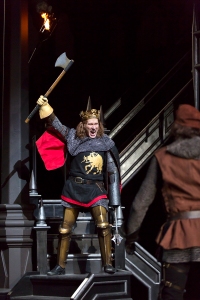 |
| Dan Donohue as Richard III. Photo courtesy Oregon Shakespeare Festival. |
When last we saw Dan Donohue, it was as an extraordinarily deep and well-developed Prince of Denmark in OSF’s 2010 production of Hamlet. Four years later, he has returned to headline this year’s headline play: A complex, modern interpretation of Richard III, Shakespeare’s last and most famous History.
Richard III was originally created to discredit the titular ruler to a queen who despised him. Because of this, many productions have cast Richard III as a hunchbacked villain, closer to Iago than Brutus. However, OSF’s current production takes cues from modern historical dramas, which are often bloody and morally ambiguous. Richard is no longer seen as someone driven to do evil because he is evil, but an ambitious person who lets his drive get the best of him. (Incidentally, this influence can also be seen in the sets and costumes–lots of angles and dark colors contrasted with bright reds and golds.)
Donohue’s interpretation of Richard III, if not sympathetic, is certainly understandable. Up until he orders the assassination of children, it seems like all of his actions are calculated to win him the English throne. His actions are not committed with greater malice than can be expected from a relatively ambitious man in his position. This interpretation makes his subsequent descent into madness and death vivid and more intriguing to the audience.
Audiences who are familiar with the cackling force of evil from other versions of Richard III will find the OSF version a breath of fresh air, though there is something for audiences at all levels of Shakespearean experience. By employing modern sensibilities in a realistic interpretation of Shakespeare, OSF seeks to capture a greater audience while staying true to its theatrical goals.
No comments:
Post a Comment
Note: Only a member of this blog may post a comment.